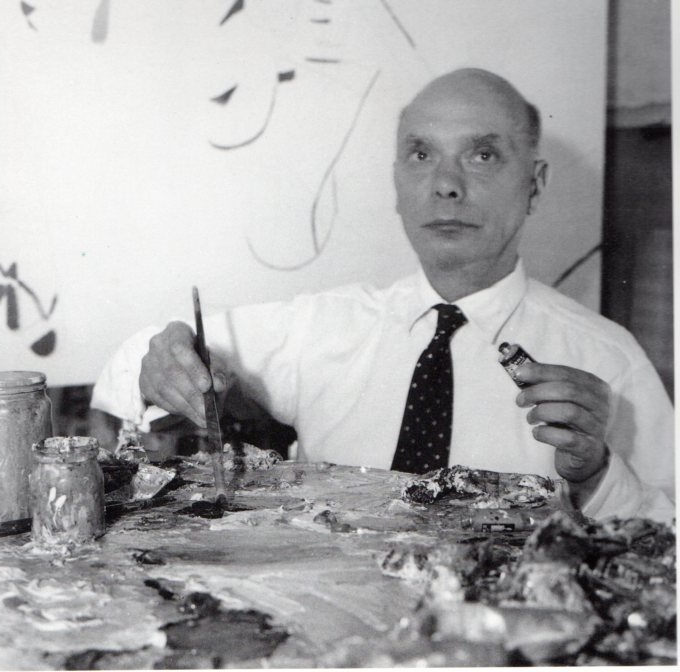Art Investment
Lanskoy Andrey Mikhailovich
1902–1976
Pseudonyms,autonyms and aliases: André
БИОГРАФИЯ

LANSKOY Andrey Mikhailovich
Painter, graphic artist
The painter was born to the family of counts Lanskoys. In 1908 family moved to St. Petersburg, where Lanskoy entered the Page Corps. One year later he left the school on his own volition and by parent’s consent. Since early childhood Lanskoy took an interest in Russian folklore and fair performances. He tried to move in artistic circles. Interiors of St. Petersburg cabarets, in particular wall paintings of a famous artist and scene-designer Sergey Sudeikin, made a tremendous impression on Lanskoy; afterwards it influenced on his creative work.
After revolution in 1917, Lanskoy moved to Kiev, attended the workshop of bright representative of cubism style Alexandra Exter. Lanskoy drew his first watercolors and gouaches; unfortunately they were lost. Then he joined as a volunteer the White Army and in 1920 left Russia with the Army forever. In 1921 Lanskoy studied in the Academy Grande Chaumière, met V. S. Barth and the idol of his youth S. Y. Sudeikin. The career of an artist Lanskoy began in France. He lived in one of the centers of Russian emigration — the Montparnasse quarter, in the young artist’s residence La Ruche.
In 1923 Lanskoy for the first time exposed his works at the exhibition of the group of Russian artists Udar (“Stroke”) in the gallery La Licorne. Paintings by Lanskoy at the exhibition were in primitivism style with bright colors and special texture. Lanskoy attached importance to the light in painting; he considered light the first element, which organizes the rest: drawing, composition, rhythm. Lanskoy was known as a creator of color–light, not only physical, but mystical light, which illuminates stained-glass windows of Christian cathedrals of Europe. That is why Lanskoy’s palette was characterized by unique color gamma, which stands out from works of figurative art painters of 1920s. Lanskoy differed from many other painters of Paris School for his Slavic element in paintings. In 1920s Lanskoy painted in such style still lifes, landscapes, family portraits and scenes in the interior: City landscape (1923), Banquet (circa 1925), Comedians (1925).
In 1925 his first personal exhibition was held in Paris. Lanskoy also participated in group exhibitions with Russian painters V. S. Barth, T. A. Tereshkovich, I. A. Pougny, P. F. Chelishchev, and M. Z. Chagall. Lanskoy took part in the Salons: Autumn, the Tuileries, May, New realities. Famous collectors L. Zborovsky, W. Uhde, R. Dutilleul bought a lot of works by Lanskoy.
In late 1920s the color gamma of Lanskoy’s works became lighter, the texture — less heavy. He painted idyllic compositions Cafe, Composition (1927–1928), Portrait of the countess Lanskaya (circa 1930). Depicting people Lanskoy was not interested in their social or psychological characteristics. He created sacral atmosphere in seemingly banal scenes of everyday life.
Since 1937 Lanskoy left figurative art under the influence of V. V. Kandinsky and P. Klee. In 1942 Lanskoy exposed his first abstract paintings at the personal exhibition in the gallery Berri-Raspail. Gradually Lanskoy came to new for him form of art — semi-figurative and already abstract style. In his paintings the figurative elements fell into geometric forms, the abstract elements were painted as color spots. Lanskoy chose gouache (not oil) for his non-figurative paintings.
Later the color became the only subject of Lanskoy’s paintings. Somber colors began to prevail in his gouaches; geometric figures replaced animated figures. His famous works of that period were Portrait of a man (1938–1940), The thinker (1940), Landscape with bicyclist (1941).
In 1945 Lanskoy created art style of lyric abstraction, abstract expressionism or action painting. The main idea was to left geometrical European constructivism, which dominated in abstractionism of 1920s–1930s, and to find self-expression of inner man of the painter. However, until 1946–1947 Lanskoy painted figurative and non-figurative elements, for example his gouache Composition (1946).
Even later figurative elements did not disappear in works by Lanskoy: The evening fair (1956), Hungarian holiday (1956), Brutality of red (1959). The favorite motif in late paintings by Lanskoy was the religion: in early 1960s he painted a series of gouaches for Genesis, in 1964 — Theology and urbanism.
Lanskoy was engaged in different art activities. He created a series of many-colored carpets: in 1958 — carpet for the ship France. He illustrated books, created collages. In 1974 Lanskoy made mosaics for the faculty of sciences in Rennes. In late 1960s Lanskoy began to realize his old project — illustrations to Diary of a Madman by Gogol. However, the painter did not have enough time to complete this work. In 1976 he died in Paris.
Новости - Hot news
Открыты 478-е торги AI Аукциона
01.05.2023Неизвестный известный Серж Иванов. 1893–1983
06.03.2023Открыты 469-е торги AI Аукциона
27.02.2023Открыты 429-е торги AI Аукциона
12.05.2022The king walks in any weather. Personal exhibition of artist Andrew Munz AI in the gallery "XXI century. Contemporary Russian art"
17.08.2020A common story: Artsy. Part 1
13.08.2020Open 342-е the Auction and 28-й curator's auction "XXI century"
11.08.2020Artist of the week: Leonid Purygin
10.08.2020Cross-trades in the summer of 2020. ArtTactic Report
06.08.2020Услуги ARTinvestment
Арт-консалтинг
Индивидуальные консультации от опытных искусствоведов по любым вопросам в сфере искусства
Составление Инвестиционного Портфеля
Подбор предметов искусства для инвестирования под любую инвестиционную стратегию
Индивидуальная оценка
Наши эксперты проведут профессиональную оценку вашего предмета искусства, учитывая его состояние, авторство, историю и другие факторы
Проведенных аукционов
Зарегистрированных пользователей на аукционе
Записей в базе
Художников в базе

